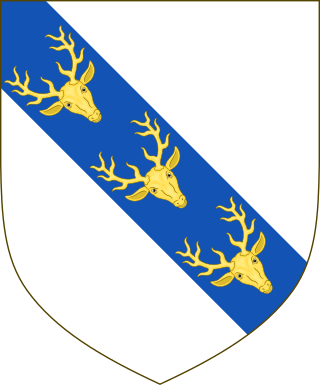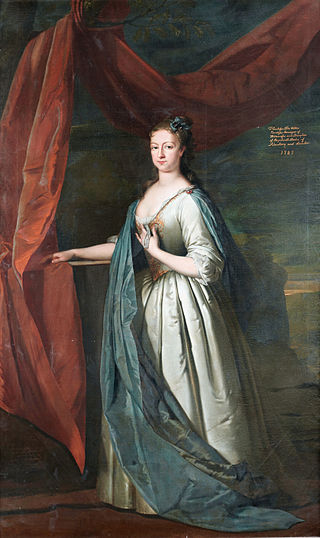Related Research Articles

Baron Audley is a title in the Peerage of England first created in 1313, by writ to the Parliament of England, for Sir Nicholas Audley of Heighley Castle, a member of the Anglo-Norman Audley family of Staffordshire.

Baron de Ros of Helmsley is the premier baron in the Peerage of England, created in 1288/89 for William de Ros, with precedence to 24 December 1264. Premier baron is a designation and status awarded to the holder of the most ancient extant barony of the Peerage of England. Before the Dissolution of the Monasteries the Prior of the Order of St John in England was deemed the premier baron.

Baron Hastings is a title that has been created three times. The first creation was in the Peerage of England in 1290, and is extant. The second creation was in the Peerage of England in 1299, and became extinct on the death of the first holder in c. 1314. The third creation was in the Peerage of England in 1461, and has been in abeyance since 1960.

Baron de Clifford is a title in the Peerage of England. It was created in 1299 for Robert de Clifford (c.1274–1314), feudal baron of Clifford in Herefordshire, feudal baron of Skipton in Yorkshire and feudal baron of Appleby in Westmoreland. The title was created by writ, which means that it can descend through both male and female lines. The Norman family which later took the name de Clifford settled in England after the Norman Conquest of 1066 and was first seated in England at Clifford Castle in Herefordshire. The first Baron served as Earl Marshal of England but was killed at the Battle of Bannockburn in 1314. His 8th generation descendant the 11th Baron, was created Earl of Cumberland in 1525, whose grandson the 3rd Earl was a noted naval commander. On the latter's death in 1605, the earldom passed to his younger brother, the 4th Earl.

Baron Willoughby de Eresby is a title in the Peerage of England. It was created in 1313 for Robert de Willoughby. Since 1983, the title has been held by Jane Heathcote-Drummond-Willoughby, 28th Baroness Willoughby de Eresby.

Baron Wharton is a title in the Peerage of England, originally granted by letters patent to the heirs male of the 1st Baron, which was forfeited in 1729 when the last male-line heir was declared an outlaw. The Barony was erroneously revived in 1916 by writ of summons, thanks to an 1844 decision in the House of Lords based on absence of documentation. As such, the current Barony of Wharton could more accurately be listed as a new Barony, created in 1916, with the precedence of the older Barony.

Baron Berners is a barony created by writ in the Peerage of England.
Baron Darcy de Knayth is a title in the Peerage of England. It was created in 1332 for John Darcy with remainder to his heirs general, allowing daughters to inherit.

Earl of Yarborough is a title in the Peerage of the United Kingdom. It was created in 1837 for Charles Anderson-Pelham, 2nd Baron Yarborough.

Baron Hungerford is a title in the Peerage of England. It was created on 7 January 1426 for Walter Hungerford, who was summoned to parliament, had been Member of Parliament, Speaker of the House and invested as Knight of the Order of the Garter before and was made Lord High Treasurer one year before he became a peer. The man who would later succeed as third baron was created Baron de Moleyns on 13 January 1445 by writ of summons; both titles merged when he succeeded as Baron Hungerford in 1459. The third baron was attainted and the peerage forfeit in 1461. This attainder was reversed in 1485 for the then 4th baroness of Hungerford, and so it came into the Hastings family of Earls of Huntingdon until 1789, when it came into the Rawdon(-Hastings) family of the Marquesses of Hastings until 1868 when it fell into abeyance. This abeyance was terminated three years later for a member of the Abney-Hastings family and an Earl of Loudoun. In 1920 it again fell into abeyance, which was terminated one year later for the Philipps family of the Viscounts of St Davids where it has remained since.
Baron Furnivall is an ancient title in the Peerage of England. It was originally created when Thomas de Furnivall was summoned to the Model Parliament on 24 June 1295 as Lord Furnivall. The barony eventually passed to Thomas Nevill, who had married the first baron's descendant Joan de Furnivall, and he was summoned to parliament in her right. Their daughter, Maud de Neville, married John Talbot, who was also summoned to parliament in her right. He was later created Earl of Shrewsbury. On the death of the seventh earl in 1616, the barony fell into abeyance. The abeyance was terminated naturally in favour of the earl's daughter Alethea Howard in 1651 and passed through her to the Dukes of Norfolk. On the death of the ninth Duke in 1777, the barony again fell into abeyance. In 1913 the abeyance was terminated again in favour of Mary Frances Katherine Petre, daughter of Bernard Petre, 14th Baron Petre. Through her father she was a great-great-great-granddaughter of the ninth Baron Petre and his first wife Anne Howard, niece of the ninth Duke of Norfolk, who became co-heir to the Barony on her uncle's death in 1777. On Lady Furnivall's death in 1968 the barony fell into abeyance for the third time.

Baron Conyers is a title in the Peerage of England. It was created on 17 October 1509 for William Conyers, the son-in-law of William Neville, 1st Earl of Kent. The abeyance after the death of the 3rd baron was terminated for the 7th Baron Darcy de Knayth, these baronies were held together until the abeyance of 1888, after which the abeyance of these two baronies were separately terminated. Since 1509, the Barons Conyers had held a part of the "right" to the barony Fauconberg, i.e. the part for which the abeyance was terminated in 1903; and since the termination of the abeyance of the barony Fauconberg, the two baronies, Conyers and Fauconberg, had been held together; from 1948 they were abeyant between the two daughters of the 5th Earl of Yarborough. On the death of the younger daughter in 2012 the abeyance terminated automatically in favour of her elder sister, the 15th holder of the title. Since the death of the latter in 2013, the title is in abeyance once more.
The title Baron Ferrers of Chartley was created on 6 February 1299 for John de Ferrers, son of Robert de Ferrers, 6th Earl of Derby. The daughter of the 6th Baron Ferrers of Chartley, Anne, married Walter Devereux who was summoned to parliament as Lord Ferrers in her right. Their descendants became Earls of Essex and the peerage was forfeited in 1601 on the attainder of Robert Devereux, 2nd Earl of Essex, but restored to his son Robert in 1604, on whose death in 1646 the peerage fell into abeyance. The abeyance was terminated in 1677 when Robert Shirley, a grandson of one of the sisters of the 3rd Earl of Essex, was summoned as Lord Ferrers of Chartley with precedence to the original creation. In 1711, Shirley was created the 1st Earl Ferrers, but the Earldom and Barony separated at his death, the barony going to Elizabeth Shirley, the daughter of his eldest son, while the earldom went to his second son. On the 1741 death of Elizabeth Shirley, 15th Baroness Ferrers of Chartley and wife of the Earl of Northampton, the peerage again briefly fell into an abeyance that was resolved in 1749 by the death of two of the three heiresses, leaving the surviving daughter, Charlotte Compton, wife of the Marquess Townshend, as 16th Baroness Ferrers of Chartley. The barony continued, merged with the marquessate, until the death of George Ferrars Townshend, 3rd Marquess Townshend in 1855, when it again fell into abeyance between his two sisters and their heirs. It remains in abeyance.

Marcia Amelia Mary Pelham, Countess of Yarborough and 13th Baroness Conyers and 7th Baroness Fauconberg, OBE was a British peer who worked in politics for the Conservative Party.

Violet Ida Eveline Herbert, Countess of Powis and suo jure16th Baroness Darcy de Knayth was a British peeress in her own right.

Baron Stanley is an abeyant title in the Peerage of England. It was created in 1456 for Sir Thomas Stanley. His son was created Earl of Derby in 1485 and the titles remained united until the death of the fifth earl, without male heirs in 1594, when the barony became abeyant. On 7 March 1921, the abeyance was terminated in favour of the 12th Countess of Loudoun, but upon her death in 1960, it became abeyant among her daughters.
The title Count of Mértola was granted to Frederick, 1st Duke of Schomberg by Afonso VI of Portugal, in 1663, as a reward for the Duke's service with the Portuguese Army.
Sackville George Pelham, 5th Earl of Yarborough, MC, styled Lord Worsley from 1914 to 1926 and known as The Lord Conyers from 1926 until his accession to the earldom in 1936, was a British peer and soldier.
Diana Mary Miller, 11th Countess of Mértola, 15th Baroness Conyers, 9th Baroness Fauconberg was the eldest daughter of Sackville Pelham, 5th Earl of Yarborough.

Frederica Susanna Mildmay, Countess FitzWalter, 3rd Countess of Mértola was a British peeress.
References
- ↑ www.historyofparliamentonline.org
- ↑ Mosley, Charles (ed.) (2003). Burke's Peerage & Baronetage, 107th edn . London: Burke's Peerage & Gentry Ltd. p. 1028 (DARCY DE KNAYTH, B). ISBN 0-9711966-2-1.
{{cite book}}:|first=has generic name (help) - ↑ Parliamentary Debates (Hansard)
- ↑ www.parliament.uk
- ↑ www.hereditarypeers.com
- ↑ "Daily Telegraph Announcements – Lycett". The Daily Telegraph. London. Archived from the original on 2 February 2014. Retrieved 16 June 2012.
- ↑ "Peerage News – FAUCONBERG (E 1283) and CONYERS (E 1509) baronies automatically terminated upon the death of one of the two co-heiresses" . Retrieved 16 June 2012.
- ↑ "Peerage News – FAUCONBERG, Rt Hon (9th) Baroness and (15th) Baroness CONYERS (1920–2013) TITLES IN ABEYANCE" . Retrieved 25 January 2014.
- ↑ George Edward Cokayne's Complete Baronetage 1900
Notes
- Sir Harris Nicolas & William Courthope. The historic peerage of England: exhibiting, under alphabetical arrangement, the origin, descent, and present state of every title of peerage which has existed in this country since the Conquest; being a new edition of the "Synopsis of the Peerage of England", John Murray, 1857 pp. 184,185